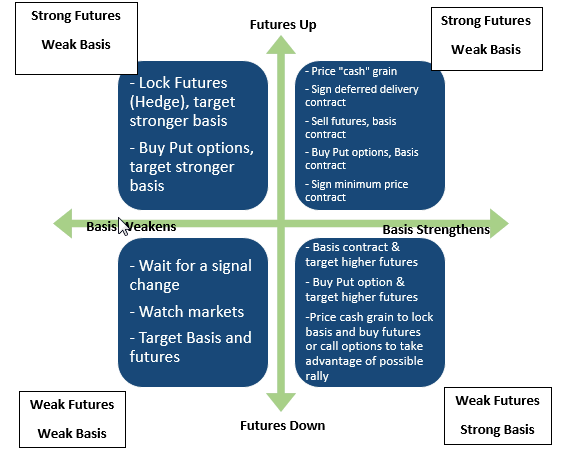| | Introduction
Strong marketing skills are important for a successful farm. This article will describe a decision process that can be used to help make grain-marketing decisions.
For an introduction to the topic see “Developing a Marketing Plan for Your Crops” on our YouTube channel: https://www.youtube.com/watch?v=drwUuM4vh20
Why Use a Decision Grid?
Farmers are faced with more pricing and marketing alternatives than ever before. Should they spot price? Hedge? Forward contract? Lock in basis? There are many alternatives available, and properly used they can help manage price risk. However, farmers must know when and how to use each one.
There are a considerable number of pricing and delivery alternatives for marketing crops. Farmers must assess all of these marketing alternatives to make sound crop marketing decisions. Marketing alternatives and signals may be different when making marketing decisions about binned crop (where you have full information) and crop that’s still growing in the field (where there is still uncertainty about yield, quality, and grade).
The market decision processes presented in this article can be applied to all crops that use futures markets for price discovery.
The Decision Grid
The decision grid helps to analyse prices and breaks these prices down to their component parts – futures and basis.
The futures price is the price that is traded on futures markets. A strong futures price is one that is high or higher than expected under current circumstances. This doesn’t mean that the futures price is at, near, or above historical highs.
The basis is the difference between the futures price and the local cash price. A strong (narrow) basis means that the cash price is high relative to the futures market. This usually means that local supplies are limited or that local demand is strong. A weak (wide) basis means that the cash price is low relative to the futures market. This signals weak local demand or over supply in the local market.
As marketers develops experience over time, they are able to determine what are historically strong or weak futures prices and basis levels. This decision grid can be used to help choose your marketing tools to mitigate price risk and take advantage of favourable changes in the market.

First let’s look at the decision grid, starting with “strong futures, weak basis”. This is a signal to take action on the strong futures price and to wait for better basis. One way to do this is to sell deferred futures and store your grain while targeting a stronger basis level. A second way to do this is to buy a put option, which sets a minimum futures price for your grain.
Now, let’s look at “strong futures, strong basis”. This is a signal to price cash grain or sign a deferred delivery contract to lock in the good basis and futures price. Some producers may consider just locking in the basis by signing a basis contract with a physical grain buyer, and use their futures account to lock the futures or buy a put option if there was a strong indication of higher prices yet. The use of one’s own commodity futures account retains more marketing flexibility.
Next, let’s look at “weak futures, weak basis”. This scenario often occurs during or after harvest, when many farmers are looking to sell and storage may be filling up. This situation is a signal to store your grain and keep a close eye on the markets for opportunities. Wait for the basis or the futures price to improve. Consider using the cash advance program to assist with cash flow needs while you wait for a favourable market change.
Finally, let’s look at “weak futures, strong basis”. If futures prices are lower than expected, but local buyers are still bidding on deliveries, basis may be strong. One approach here is to sell your grain at the cash price to take advantage of the strong basis. Having locked in the basis by selling your physical grain, you may purchase futures or call options to reopen price upside to take advantage of a rally in the futures price. This strategy has the added advantage of getting cash from the grain and eliminating storage risk. Alternatively, you could sign a basis contract to lock in the favourable basis level while you wait for a higher futures price to complete your pricing.
Summary
The key to making solid grain marketing decisions is keeping informed. Having a marketing plan with reasonable profit targets will help you capitalise on marketing opportunities when they arise.
Other Resources
These related articles are located in the Agricultural Marketing Guide:
Introduction to Crop Marketing
Crop Contracts
Basis – How Cash Grain Prices are Established
Using Hedging to Protect Farm Product Prices
Grain Storage as a Marketing Strategy |
|